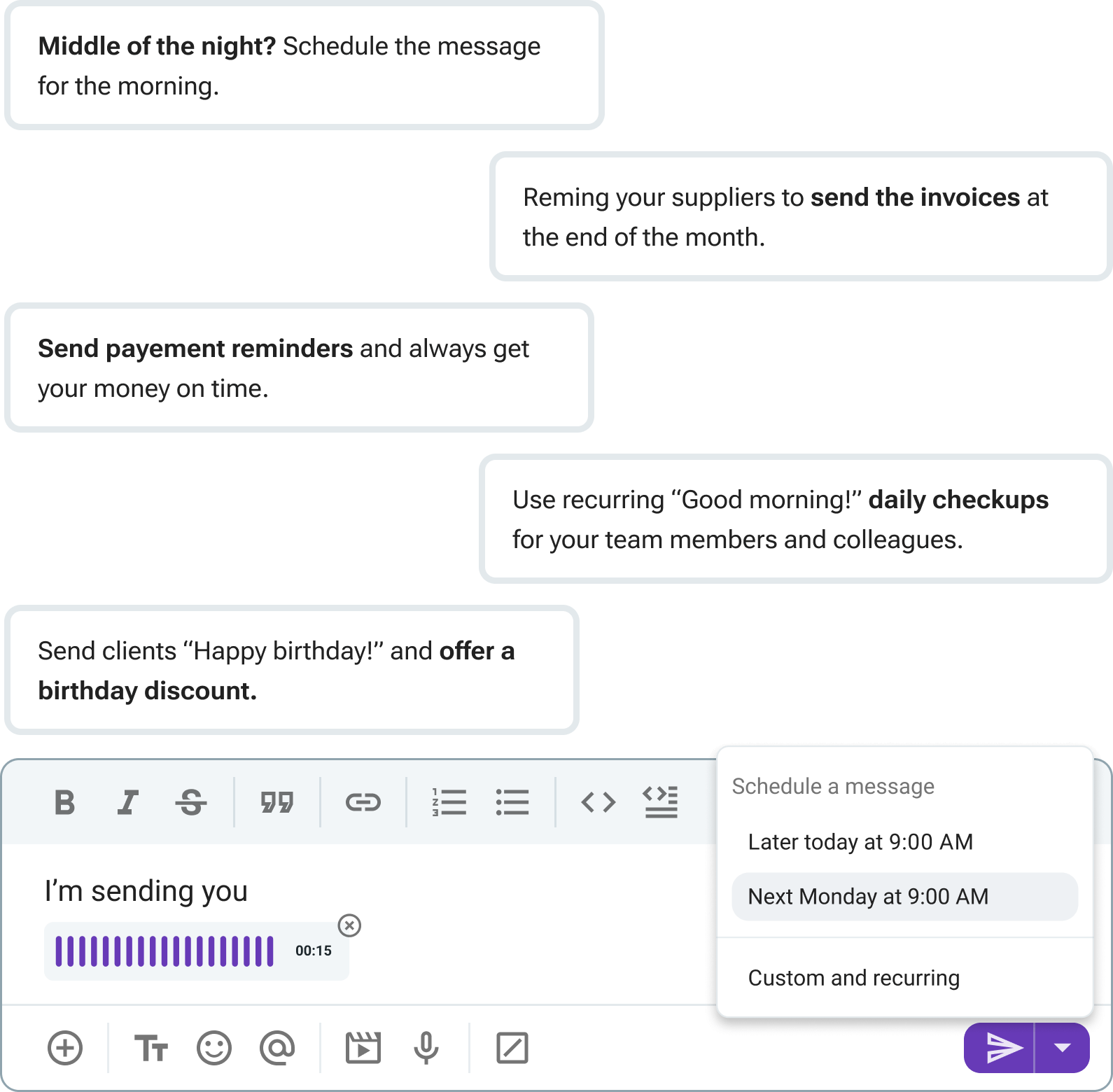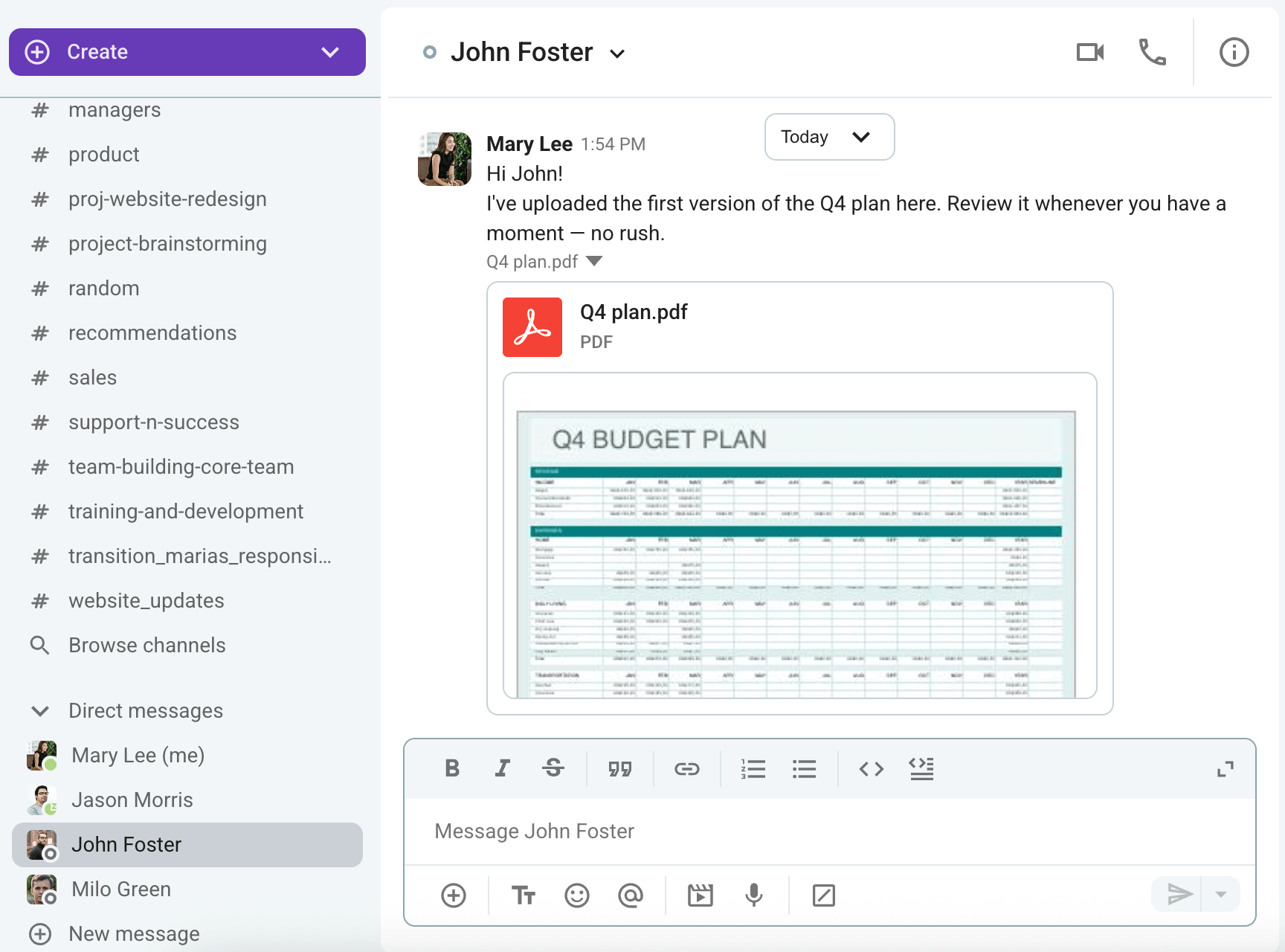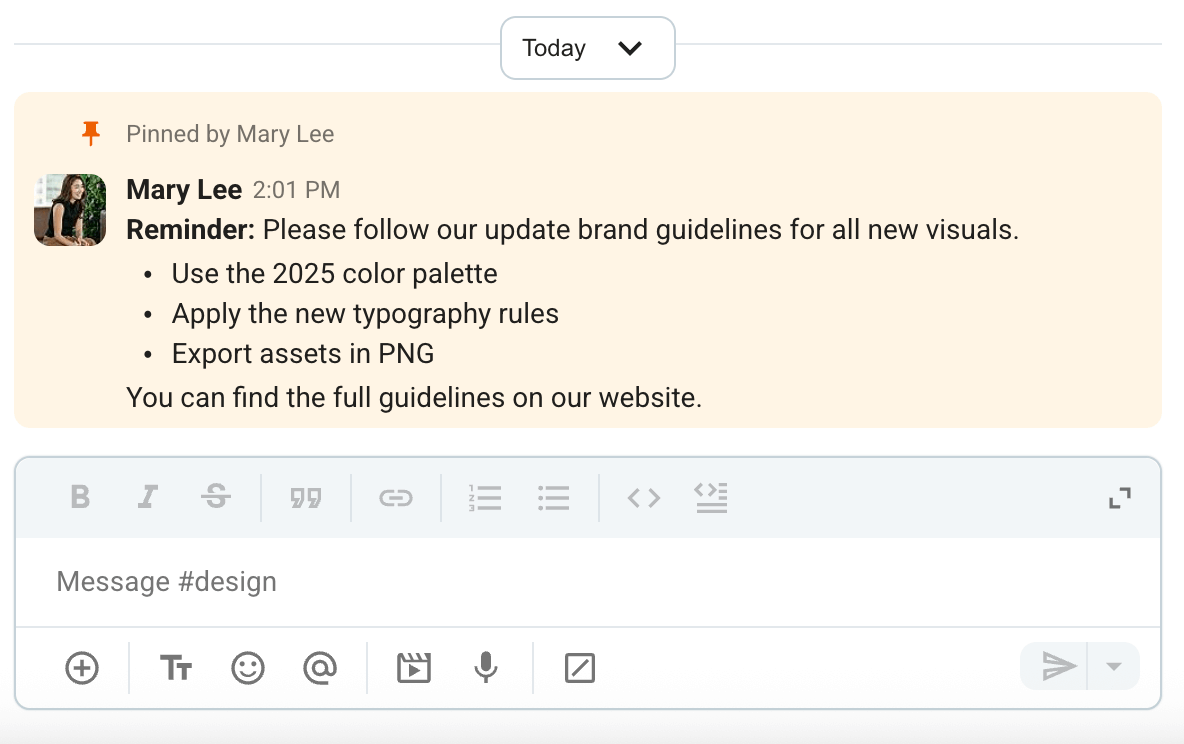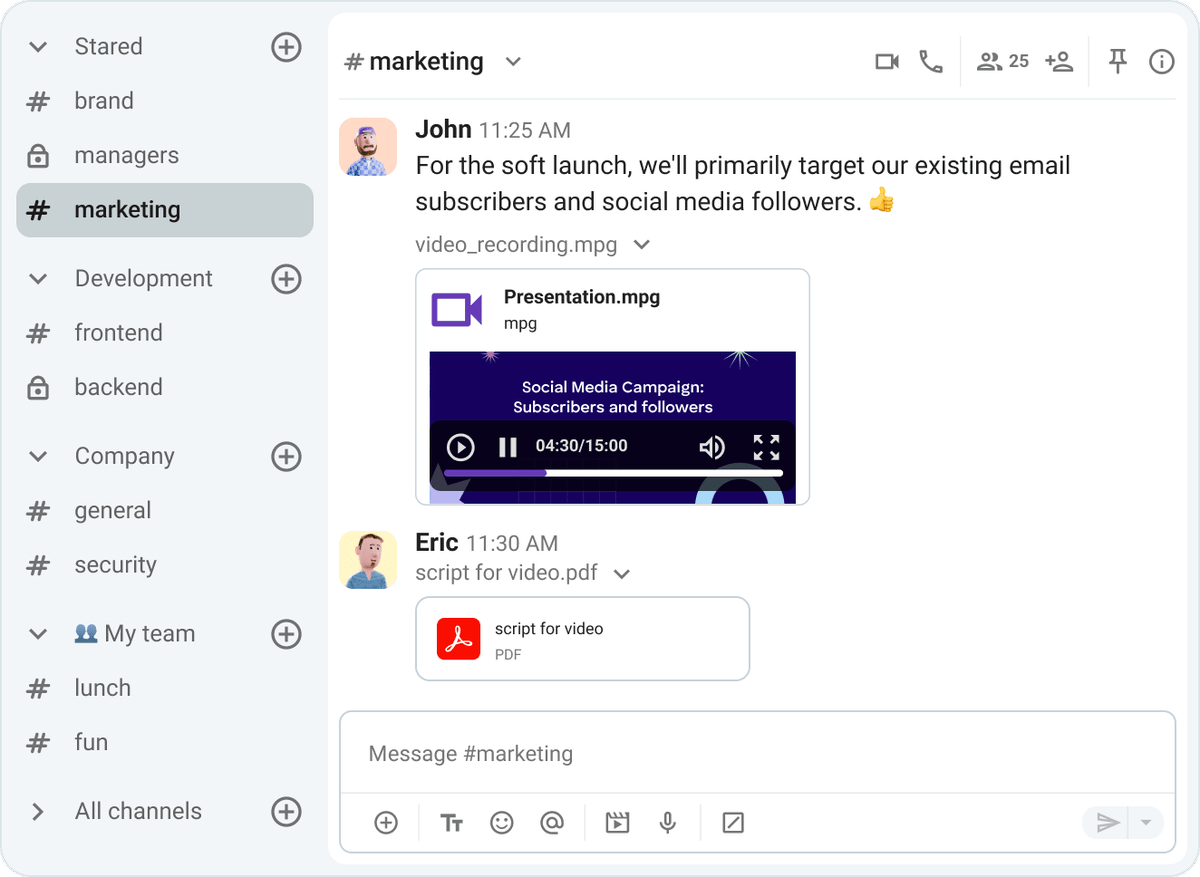Staying on top of work shouldn’t require you or your team to be “always on”.
Yet, many workplaces still operate in a synchronous-by-default culture that fuels back-to-back meetings, notification fatigue, and eventual burnout.
When everyone is expected to respond right away, focus disappears, and your team ends up exhausted and somehow always behind.
That’s why more teams are turning to asynchronous communication.
In this blog post, we’ll:
- Learn what asynchronous communication is,
- Explore its benefits, and
- Share a 5-step playbook on how to incorporate it into your work culture.
Let’s start!

Table of Contents
What is asynchronous communication?
Asynchronous communication is characterized by a time gap between message transmission and reception. In other words, asynchronous communication is any communication where the response isn’t instantaneous.
It gives teams the space to think, prioritize, and contribute without the pressure of real-time availability.
Examples of asynchronous communication include:
- Text messaging,
- Voice and video messages,
- Emails,
- File sharing, and
- Collaborating on documents.
As businesses embrace virtual team collaboration, teams have adopted asynchronous communication as a standard practice that is not restricted by time or location.
💡 PUMBLE PRO TIP
If you’re uncertain if asynchronous communication can replace face-to-face interactions, here’s what to consider and how to make it happen:
How to choose between synchronous vs asynchronous communication?
On the other hand, synchronous communication refers to real-time interactions where participants engage simultaneously. Synchronous communication allows for immediate exchange of information and feedback.
To better understand the differences, let’s look at examples of when to use synchronous vs asynchronous communication.
| Synchronous communication | Asynchronous communication |
|---|---|
| Problem solving | Status updates |
| Quick questions | Giving feedback |
| Brainstorming | Planning / scheduling |
| Aligning on decisions | Sharing project documents |
| Celebrations / team culture | Routine check-ins |
💡 PUMBLE PRO TIP
Instant messaging meets at the halfway point between synchronous and asynchronous communication — it’s not exactly instantaneous, but it’s still a fast and effective way to get in touch with a team member. To find out more about the benefits of instant messaging in business communication, read our blog post:
The 5 business benefits of an async-first culture
Here are some of the ways asynchronous communication can transform how your team works.
#1 Reclaims deep work and boosts productivity
Asynchronous communication supports your team’s productivity by protecting focus time.
Low-priority tasks, like responding to non-urgent messages, can interrupt deep work and drain overall efficiency. Recent research highlighted in Gloria Mark’s book Attention Span shows it can take up to 25 minutes to regain focus on a project after an interruption.
In contrast, giving yourself time to respond without the pressure of real-time availability lets you stay focused on the task at hand and maintain true, distraction-free work.
To put this into practice, you can schedule messages in your team communication app like Pumble and plan communication around peak productivity hours.

By avoiding the disruption of immediate responses, you manage expectations around availability and response times more effectively.
#2 Reduces meeting fatigue and burnout
Solely relying on synchronous communication often leads to a heavy load of meetings, whether in person or through video calls.
And while meetings are valuable in certain situations, they can quickly take over your team’s schedule and become overwhelming, eventually contributing to burnout. In fact, employees spend an estimated 31 hours in unproductive meetings each month. This can lead to decreased productivity and frustration rather than effective communication.
With asynchronous communication, team members can respond at their own pace. Nobody feels left behind, and the fear of missing out or not replying immediately starts to fade.
This gives your team more time to focus on actual work instead of stretching themselves too thin trying to attend every meeting and respond to everything in real time.
💡 PUMBLE PRO TIP
If back-to-back meetings are draining your productivity, here’s how to overcome the noise and take back your focus:
#3 Builds a permanent, searchable company brain
Asynchronous communication relies heavily on written or recorded messages, not real-time conversations. This means information is captured by default, instead of disappearing the moment the meeting ends.
Over time, all information shared in your business messaging app creates a living knowledge base — a permanent, searchable record of:
- How the team works,
- What decisions were made, and
- Where important context and files live.

Even your synchronous communication benefits from this. Using a tool like Pumble allows you to record your meetings and share them with your team for future reference, adding them to your collective knowledge base.
Pumble also has unlimited message history for all of its users, which ensures you and your team have permanent, free access to your conversations and shared information.
#4 Enables real flexibility for global and remote teams
If you’re part of a global or remote team operating across time zones, synchronous communication can be a real hassle.
Coordinating schedules for calls, having team members come in early or stay late, and waiting for someone to be online slows everything down.
Keeping your communication asynchronous lets your team:
- Catch up at their own pace,
- Work when they’re most productive,
- Receive equal support regardless of time zone, and
- Ensure projects keep moving even when schedules don’t overlap.
#5 Fosters more thoughtful, high-quality communication
Having to take action on the spot with real-time communication may not be the best approach for informed and confident decision making.
High time pressure, such as in face-to-face meetings, can lead to risky decisions, rushed discussions, and potentially faulty decisions.
With asynchronous communication, you have the time to reflect and carefully consider the information you have, leading to better outcomes.
Ultimately, this also helps foster more thoughtful, high-quality communication with fewer misunderstandings and greater transparency.
How to implement asynchronous communication in 5 easy steps
Getting all the benefits of asynchronous communication requires some consideration and the implementation of a few key strategies.
Here’s how to make it work in 5 easy steps.
Step #1: Audit your meetings
If your employee morale and productivity are suffering because of meeting overload, it’s time to reevaluate your routines.
Review all recurring meetings and their participants. Identify:
- Which are essential,
- Which can be reduced or removed, and
- Which could be replaced with asynchronous updates.
This frees up valuable time and ensures meetings are intentional, not just habitual.
Step #2: Set clear expectations
Clear expectations prevent miscommunication, reduce anxiety, and help employees prioritize their work with confidence.
To make asynchronous work for your team, outline guidelines such as:
- Specific hours when employees are expected to be available,
- Reasonable response time windows,
- Communication etiquette rules, and
- Which situations call for synchronous over asynchronous communication.
Step #3: Master the art of written communication
Encourage your team to communicate clearly in written form, including:
- Context,
- Decisions, and
- Next steps.
This might require some training in concise, structured messaging, but it pays off. Better written messages reduce misunderstandings and unnecessary follow-ups.

💡 PUMBLE PRO TIP
Struggling to get your message across in writing? Read our blog post to sharpen your skills:
Step #4: Document discussions and decisions
For asynchronous communication to work, everyone needs easy access to all relevant information.
Keep your channels and groups up to date and make sure all relevant participants are included.
Share decisions, action items, and deadlines in accessible places such as team channels, and use Pumble’s pinned messages for important updates, project guidelines, and resources.
Being diligent about documentation keeps everyone informed and accountable for their work, especially in remote and distributed teams.

Stay on top of updates with ease
Step #5: Choose the right tools
Making the switch to more asynchronous modes of communication requires the right tools.
Choose a communication platform that supports your team’s needs and allows for sufficient collaboration without constantly relying on real-time conversations.
With the right tools in place, async communication becomes natural and effortless for everyone.
Get all the benefits of asynchronous communication with Pumble
Now that you understand the principles and benefits of asynchronous communication, you can make it a reality with Pumble by CAKE.com.
Pumble provides a range of features that support async collaboration and help teams stay aligned and productive without relying on constant real-time communication:
- Direct messages — Send quick one-on-one or group messages and updates without needing a meeting.
- Channels — Organize conversations by project, topic, or department for easy reference.
- Threads — Keep discussions focused and the main chat uncluttered.
- File sharing — Share documents and resources directly in conversations for easy access and collaboration.
- Voice and video messages — Send updates, feedback, and explanations easily, letting team members watch or listen on their own schedule.
- Message scheduling — Plan messages ahead of time to align with team productivity or different time zones.

When you do need instant, real-time communication, Pumble also supports synchronous communication with powerful video conferencing features, such as:
- Sharing your screen,
- Messaging in the call, or
- Inviting external guests to the meeting.
So, if you need a reliable and easy-to-use tool for team communication across all modes, try out Pumble!
And, to further enhance your team’s productivity, check out CAKE.com’s Productivity Bundle!






